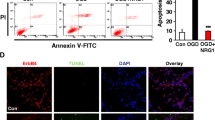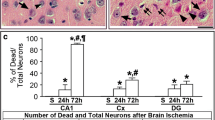Abstract
The activation of the [Ca2+]-dependent cysteine protease calpain plays an important role in ischemic injury. Here, the levels of two calpain-specific substrates, p35 protein and eukaryotic initiation factor 4G (eIF4G), as well as its physiological regulator calpastatin, were investigated in a rat model of transient global cerebral ischemia with or without ischemic tolerance (IT). Extracts of the cerebral cortex, whole hippocampus and hippocampal subregions after 30 min of ischemia and different reperfusion times (30 min and 4 h) were used. In rats without IT, the p35 levels slightly decreased after ischemia or reperfusion, whereas the levels of p25 (the truncated form of p35) were much higher than those in sham control rats after ischemia and remained elevated during reperfusion. The eIF4G levels deeply diminished after reperfusion and the decrease was significantly greater in CA1 and the rest of the hippocampus than in the cortex. By contrast, the calpastatin levels did not significantly decrease during ischemia or early reperfusion, but were upregulated after 4 h of reperfusion in the cortex. Although IT did not promote significant changes in p35 and p25 levels, it induced a slight increase in calpastatin and eIF4G levels in the hippocampal subregions after 4 h of reperfusion.




Similar content being viewed by others
References
Goll DE, Thompson VF, Li H et al (2003) The calpain system. Physiol Rev 83:731–801
Kristian T, Siesjo BK (1997) Changes in ionic fluxes during cerebral ischaemia. Int Rev Neurobiol 40:27–45
Lipton P (1999) Ischemic cell death in brain neurons. Physiol Rev 79:1431–1568
Orrenius S, Zhivotovsky B, Nicotera P (2003) Regulation of cell death: the calcium-apoptosis link. Nat Rev Mol Cell Biol 4:552–565
Rami A (2003) Ischemic neuronal death in the rat hippocampus: the calpain–calpastatin–caspase hypothesis. Neurobiol Dis 13:75–88
Bartus TR, Dean RL, Mennerick S et al (1998) Temporal ordering of pathogenic events following transient global ischemia. Brain Res 790:1–13
Markgraf CG, Velayo NL, Johnson MP et al (1998) Six-hour window of opportunity for calpain inhibition in focal cerebral ischemia in rats. Stroke 29:152–158
Ray SK, Banik NL (2003) Calpain and its involvement in the pathophysiology of CNS injuries and diseases: therapeutic potential of calpain inhibitors for prevention of neurodegeneration. Curr Drug Targets CNS Neurol Disord 2:173–189
Das A, Garner DP, Del Re AM et al (2006) Calpeptin provides functional neuroprotection to rat retinal ganglion cells following Ca(2+) influx. Brain Res 1084:146–157
Carragher NO (2006) Calpain inhibition: a therapeutic strategy targeting multiple disease states. Curr Pharm Des 12:615–638
Wingrave JM, Sribnick EA, Wilford GG et al (2004) Higher calpastatin levels correlate with resistance to calpain-mediated proteolysis and neuronal apoptosis in juvenile rats after spinal cord injury. J Neurotraum 21:1240–1254
Bano D, Young KW, Guerin CJ et al (2005) Cleavage of the plasma membrane Na+/Ca2+ exchanger in excitotoxicity. Cell 120:275–285
Higuchi M, Tomioka M, Takano J et al (2005) Distinct mechanistic roles of calpain and caspase activation in neurodegeneration as revealed in mice overexpressing their specific inhibitors. J Biol Chem 280:15229–15237
Dnyanmote AV, Sawant SP, Lock EA et al (2006) Calpastatin overexpression prevents progression of S-1,2-dichlorovinyl-l-cysteine (DCVC)-initiated acute renal injury and renal failure (ARF) in diabetes. Toxicol Appl Pharmacol [Epub ahead of print] PMID: 16546232
Kesavapany S, Amin N, Zheng YL et al (2004) p35/cyclin-dependent kinase 5 phosphorylation of ras guanine nucleotide releasing factor 2 (RasGRF2) mediates Rac-dependent extracellular signal-regulated kinase 1/2 activity, altering RasGRF2 and microtubule-associated protein 1b distribution in neurons. J Neurosci 24:4421–4431
Hahn CM, Kleinholz H, Koester MP et al (2005) Role of cyclin-dependent kinase 5 and its activator P35 in local axon and growth cone stabilization. Neuroscience 134:449–465
Tsai L-H, Delalle I, Caviness VS Jr et al (1994) p35 is a neural-specific regulatory subunit of cyclin-dependent kinase 5. Nature 371:419–426
Patrick GN, Zukerberg L, Nikolic M et al (1999) Conversion of p35 to p25 deregulates Cdk5 activity and promotes neurodegeneration. Nature 402:615–622
Lee M-S, Kwon YT, Li M et al (2000) Neurotoxicity induces cleavage of p35 to p25 by calpain. Nature 405:360–368
Wang J, Liu S, Fu Y et al (2003) Cdk5 activation induces hippocampal CA1 cell death by directly phosphorylating NMDA receptors. Nat Neurosci 6:1039–1047
Cruz JC, Tsai LH (2004) A Jekyll and Hyde kinase: roles for cdk5 in brain development and disease. Curr Opin Neurobiol 14:390–395
Zheng YL, Kesavapany S, Gravell M et al (2005) A Cdk5 inhibitory peptide reduces tau hyperphosphorylation and apoptosis in neurons. EMBO J 24:209–220
Jamsa A, Backstrom A, Gustafsson E et al (2006) Glutamate treatment and p25 transfection increase Cdk5 mediated tau phosphorylation in SH-SY5Y cells. Biochem Biophys Res Commun 345:324–331
Weishaupt JH, Kussmaul L, Grötsch P et al (2003) Inhibition of CDK5 is protective in necrotic and apoptotic paradigms of neuronal cell death and prevents mitochondrial dysfunction. Mol Cell Neurosci 24:489–502
Alvira D, Tajes M, Verdaguer E et al (2006) Inhibition of the cdk5/p25 fragment formation may explain the antiapoptotic effects of melatonin in an experimental model of Parkinson’s disease. J Pineal Res 40:251–258
Kitagawa K, Matsumoto M, Tagaya M et al (1990) “Ischemic tolerance” phenomenon found in the brain. Brain Res 528:21–24
Kirino T (2002) Ischemic tolerance. J Cereb Blood Flow Metab 22:1283–1296
Schaller B, Graf R (2002) Cerebral ischemic preconditioning. An experimental phenomenon or a clinical important entity of stroke prevention. J Neurol 249:1503–1511
Gidday JM (2006) Cerebral preconditioning and ischaemic tolerance. Nat Rev Neurosci 7:437–448
Sharp FR, Aigang L, Yang T et al (2000) Multiple molecular penumbras after focal cerebral ischemia. J Cereb Blood Flow Metab 20:1011–1032.
Burda J, Hrehorovská M, Garcia L et al (2003) Role of protein synthesis in the ischemic tolerance acquisition induced by transient forebrain ischemia in the rat. Neurochem Res 28:1213–1219
Barone FC, White RF, Spera PA et al (1998) Ischemic preconditioning and brain tolerance. Temporal histological and functional outcomes, protein synthesis requirement, and interleukin-1 receptor antagonist and early gene expression. Stroke 29:1937–1951
Nishio S, Chen ZF, Yunoki M et al (1999) Hypothermia-induced ischemic tolerance. Ann NY Acad Sci 890:26–41
Neumar RW, DeGracia DJ, Konkoly LL et al (1998) Calpain mediates eukaryotic initiation factor 4G degradation during global brain ischemia. J Cereb Blood Flow Metab 18:876–881
Martín de la Vega C, Burda J, Nemethova M et al (2001) Possible mechanisms involved in the down-regulation of translation during transient global ischaemia in the rat brain. Biochem J 357:819–826
Mengesdorf T, Althausen S, Oberndorfer I et al (2001) Response of neurons to an irreversible inhibition of endoplasmic reticulum Ca2+-ATPase: relationship between global protein synthesis and expression and translation of individual genes. Biochem J 356:805–812
García L, Burda J, Hrehorovská M et al (2004) Ischaemic preconditioning in the rat brain: effect on the activity of several initiation factors, Akt and extracellular signal-regulated protein kinase phosphorylation, and GRP78 and GADD34 expression. J Neurochem 88:136–147
Bradford MM (1976) A rapid and sensitive method for the quantitation of microgram of protein utilising the principle of protein-dye binding. Anal Biochem 72:248–254
Hou ST, MacManus JP (2002) Molecular mechanisms of cerebral ischemia-induced neuronal death. Int Rev Cytol 221:93–148
Brostrom MA, Brostrom CO (2003) Calcium dynamics and endoplasmic reticular function in the regulation of protein synthesis: implications for cell growth and adaptability. Cell Calcium 34:345–363
Zhang C, Siman R, Xu YA et al (2002) Comparison of calpain and caspase activities in the adult rat brain after transient forebrain ischemia. Neurobiol Dis 10:289–305
Siesjo BK, Hu B, Kristian T (1999) Is the cell death pathway triggered by the mitochondrion or the endoplasmic reticulum? J Cereb Blood Flow Metab 19:19–26
Shelton SB, Johnson GVW (2004) Cyclin-dependent kinase-5 in neurodegeneration. J Neurochem 88:1313–1326
Fischer A, Sananbenesi F, Pang PT et al (2005) Opposing roles of transient and prolonged expression of p25 in synaptic plasticity and hippocampus-dependent memory. Neuron 48:825–838
Nevins TA, Harder ZM, Korneluk RG et al (2003) Distinct regulation of internal ribosome entry site-mediated translation following cellular stress is mediated by apoptotic fragments of eIF4G translation initiation factor family members eIF4GI and p97/DAP5/NAT1. J Biol Chem 278:3572–3579
Hossmann KA (1993) Disturbances of cerebral protein synthesis and ischemic cell death. Prog Brain Res 96:161–177
Furuta Y, Uehara T, Nomura Y (2003) Correlation between delayed neuronal cell death and selective decrease in phosphatidylinositol 4-kinase expression in the CA1 subfield of the hippocampus after transient forebrain ischemia. J Cereb Blood Flow Metab 23:962–971
MacManus JP, Graber T, Luebbert C et al (2004) Translation-state analysis of gene expression in mouse brain after focal ischemia. J Cereb Blood Flow Metab 24:657–667
Schmidt-Kastner R, Zhang B, Belayev L et al (2002) DNA microarray analysis of cortical gene expression during early recirculation after focal brain ischemia in rat. Brain Res Mol Brain Res 108:81–93
Jin K, Mao XO, Eshoo MW et al (2001) Microarray analysis of hippocampal gene expression in global cerebral ischemia. Ann Neurol 50:93–103
Nakagomi T, Kirino T, Kanemitsu H et al (1993) Early recovery of protein synthesis following ischemia in hippocampal neurons with induced tolerance in the gerbil. Acta Neuropathol 86:10–15
Kato H, Kogure K, Nakata N et al (1995) Facilitated recovery from postischemic supression of protein synthesis in the gerbil brain with ischemic tolerance. Brain Res Bull 36:205–208
Burda J, Martin ME, García A et al (1994) Phosphorylation of the a subunit of initiation factor 2 correlates with the inhibition of translation following transient cerebral ischaemia in the rat. Biochem J 302:335–338
Martín de la Vega C, Burda J, Salinas M (2001) Ischemia-induced inhibition of the initiation factor 2a phosphatase activity in the rat brain. Neuroreport 12:1021–1025
Dirnagl U, Simon RP, Hallenbeck JM (2003) Ischemic tolerance and endogenous neuroprotection. Trends Neurosci 26:248–254
Abe H, Nowak TS Jr (2004) Induced hippocampal neuron protection in an optimized gerbil ischemia model: insult thresholds for tolerance induction and altered gene expression defined by ischemic depolarization. J Cereb Blood Flow Metab 24:84–97
Kato K, Shimazaki K, Kamiya T et al (2005) Differential effects of sublethal ischemia and chemical preconditioning with 3-nitropropionic acid on protein expression in gerbil hippocampus. Life Sci 77:2867–2878
Bukau B, Weissman J, Horwich A (2006) Molecular chaperones and protein quality control. Cell 125:443–451
Averna M, Stifanese R, De Tullio R et al (2006) Interaction between catalytically inactive calpain and calpastatin. Evidence for its occurrence in stimulated cells. FEBS J 273:1660–1668
Blomgren K (1999) Calpastatin is upregulated and acts as a suicide substrate to calpains in neonatal rat hypoxia-ischemia. Ann NY Acad Sci 890:270–271
Saido TC, Kawashima S, Tani E et al (1997) Up- and down-regulation of calpain inhibitor polypeptide, calpastatin, in postischemic hippocampus. Neurosci Lett 227:75–78
Dever TE (2002) Gene-specific regulation by general translation factors. Cell 108:545–556
Gebauer F, Hentze MW (2004) Molecular mechanisms of translational control. Nat Rev 5:827–835
Acknowledgments
This work was supported by grants SPAIN-02/0304 and 05/0312 from the Ministerio de Sanidad y Consumo (FIS), and grants SK-VEGA 2/3219/23 and APVT 51-0219-04 from the Slovak Academy of Sciences. I. Ayuso, L. García-Bonilla and D. Piñeiro gratefully acknowledge fellowships from the FIS.
Author information
Authors and Affiliations
Corresponding author
Rights and permissions
About this article
Cite this article
García-Bonilla, L., Burda, J., Piñeiro, D. et al. Calpain-induced Proteolysis After Transient Global Cerebral Ischemia and Ischemic Tolerance in a Rat Model. Neurochem Res 31, 1433–1441 (2006). https://doi.org/10.1007/s11064-006-9195-7
Received:
Accepted:
Published:
Issue Date:
DOI: https://doi.org/10.1007/s11064-006-9195-7




